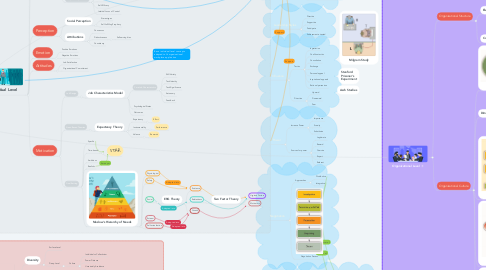
1. Leadership
1.1. Natural Traits
1.1.1. Intelligence
1.1.2. Personality
1.2. Behaviour
1.3. Context
1.3.1. Contingency Theory
1.3.2. Situational Leadership
1.3.3. Path-Goal Theory of Leadership
2. Asch Studies
3. Milgram Study
4. Stanford Prisoner's Experiment
5. Influence
5.1. Tactics
5.1.1. Ingratiation
5.1.2. Coalition tactics
5.1.3. Consultation
5.1.4. Exchange
5.1.5. Personal appeal
5.1.6. Inspirational appeals
5.1.7. Rational persuasion
5.2. Direction
5.2.1. Upward
5.2.2. Downward
5.2.3. Peer
6. Power
6.1. Increase Power
6.1.1. Importance
6.1.2. Scarcity
6.1.3. Substituion
6.2. Sources for power
6.2.1. Legitimate
6.2.2. Reward
6.2.3. Coercive
6.2.4. Expert
6.2.5. Referent
7. Leadership Styles
7.1. Directive
7.2. Supportive
7.3. Participate
7.4. Achievement-oriented
8. Negotiation
8.1. Approaches
8.1.1. Distributive
8.1.2. Integrative
8.2. Negotiation Process
9. Conflicts
9.1. Positive
9.1.1. Person-related
9.2. Negative
9.2.1. Task-related
9.3. Conflict Management
9.3.1. Avoidance
9.3.2. Accommodation
9.3.3. Compromise
9.3.4. Collaboration
9.3.5. Compeition
10. Group Level
10.1. Diversity
10.1.1. Surface Level
10.1.2. Deep Level
10.1.2.1. Culture
10.1.2.1.1. Individual vs Collectivism
10.1.2.1.2. Power Distance
10.1.2.1.3. Uncertainly Avoidance
10.1.2.1.4. Masculinity vs Femininity
10.2. Stages of Group Development
10.2.1. Forming
10.2.1.1. Storming
10.2.1.1.1. Norming
10.2.2. Punctuated-Equilibrium Model
10.2.2.1. Periods of Rapid Change
10.2.2.1.1. Forming
10.2.2.1.2. Norming
10.2.2.1.3. Performing
10.2.2.2. Periods of Stability
10.2.2.2.1. Storming
10.2.2.2.2. Performing
10.2.2.2.3. Ajourning
11. Organizational Level
11.1. Organizational Structure
11.1.1. Elements
11.1.1.1. Formalization
11.1.1.2. Departmentalization
11.1.1.2.1. Functional Structures
11.1.1.2.2. Divisional Structures
11.1.1.3. Centralization
11.1.1.4. Hierarchical Levels
11.1.1.4.1. Tall Structures
11.1.1.4.2. Flat Structures
11.1.1.4.3. Span of Control
11.1.2. Configurations
11.1.2.1. Mechanistic
11.1.2.2. Organic
11.2. Organizational Culture
11.2.1. Levels
11.2.2. Dimensions
11.2.2.1. Innovative
11.2.2.2. Agressive
11.2.2.3. Outcome-Oriented
11.2.2.4. Stable
11.2.2.5. People-oriented
11.2.2.6. Team-oriented
11.2.2.7. detail-oriented
11.2.3. Creation
11.2.4. Visual Elements
11.2.5. Change
12. Individual Level
12.1. Values
12.2. Personality
12.2.1. Big Five Personality Traits
12.2.1.1. Conscientiousness
12.2.1.2. Agreeableness
12.2.1.3. Neuroticism
12.2.1.3.1. CANOE
12.2.1.4. Openness
12.2.1.5. Extraversion
12.2.2. Helpful Workplace Traits
12.2.2.1. Self-Monitoring
12.2.2.2. Proactive Personality
12.2.2.3. Self-Esteem
12.2.2.4. Self-Efficacy
12.2.2.5. Internal Locus of Control
12.3. Perception
12.3.1. Social Perception
12.3.1.1. Stereotypes
12.3.1.2. Self-fulfilling Prophecy
12.3.2. Attributions
12.3.2.1. Consensus
12.3.2.2. Distinctiveness
12.3.2.2.1. Self-serving bias
12.3.2.3. Consistency
12.4. Emotion
12.4.1. Positive Emotions
12.4.2. Negative Emotions
12.5. Attitudes
12.5.1. Job Satisfaction
12.5.2. Organizational Commitment
12.6. Motivation
12.6.1. Job Design
12.6.1.1. Job Characteristics Model
12.6.1.1.1. Core Job Characteristics
12.6.1.1.2. Psychological States
12.6.1.1.3. Outcomes
12.6.2. Need Based Theories
12.6.2.1. Expectancy Theory
12.6.2.1.1. Expectancy
12.6.2.1.2. Instrumentality
12.6.2.1.3. Valence
12.6.3. Goal-Setting
12.6.3.1. Specific
12.6.3.2. Time-bound
12.6.3.2.1. STAR
12.6.3.3. Ambitious
12.6.3.4. Realistic
12.6.3.5. Maslow's Hierarchy of Needs
12.6.3.5.1. Physiological
12.6.3.5.2. Safety
12.6.3.5.3. Social
12.6.3.5.4. Esteem
12.6.3.5.5. Self-actualization
